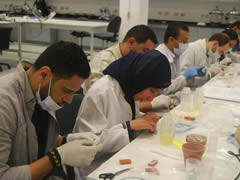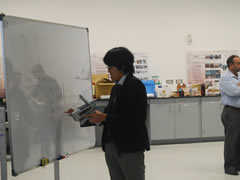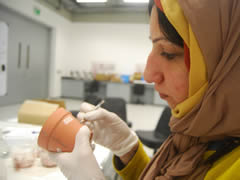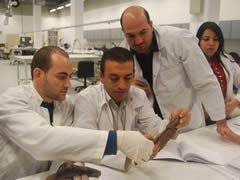- Home
- Technical Cooperation Projects
- Index of Countries
- Middle East
- Egypt
- The Project for the Conservation Center in the Grand Egyptian Museum
- Project News
- Inorganic objects Training course (non-metal) II
Project News
2015-11-09
Inorganic objects Training course (non-metal) II
At the Grand Egyptian Museum Conservation Center (GEM-CC), Japan International Cooperation Agency (JICA) conducted the training course on Inorganic objects (non-metal) II from 1st~9th November by inviting 5 experts from Japan as follows:
- Mr. Takashi Oikawa: conservator (Freelance)
- Dr. Yoshinari Abe: Scientist (Tokyo University of Science)
- Ms. Hohi Kobayashi: Conservator (Freelance)
- Ms. Michiko Koga: Conservator (Freelance)
- Dr. Yoshiko Shimazu: Conservation scientists (National Historical Museum)
The purpose of this training course is to deepen the understanding of the trainees about materials used in conservation while consolidating their knowledge about damage and deterioration aspects of inorganic (non-metal) artifacts as well as treatments of such damages including cleaning and joining.
In order to make an appropriate conservation plan it is important to fully grasp the composition of the artifact materials and its condition, so Dr. Abe gave a lecture that aimed to increase the understanding of materials science regarding pottery, faience and glass as well as its deterioration mechanism. Moreover, trainees used different kinds of observation methods (Microscope, XRF and XRD) which increased their understanding of artifacts' materials and the deterioration mechanism.
Additionally, Dr. Shimazu and Mr. Oikawa gave a lecture on polymers and solvents consolidating trainees' scientific background about removing and cleaning of previous conservation materials. In the same time expanding their options when choosing cleaning materials by introducing new materials and increasing their experience through practice.
Ms. Koga and Ms. Kobayashi introduced different kinds of adhesives and filling materials by having them do a practical experiment, establishing the trainees understanding of each type regarding its chemical composition, effect and ease of use when dealing with Pottery, Faience and glass which are all materials that have different characteristics, furthermore, enforcing the importance of considering the condition of each artifact and the purpose of conservation first hand when selecting the joining and filling method and materials that will be used in the process.
Finally, this was the last of 3 consecutive training courses on inorganic objects, which has also received great popularity among trainees.
 Trainees experimenting with different adhesives and joining techniques.
Trainees experimenting with different adhesives and joining techniques.
 Dr. Abe demonstrating using the XRF analysis.
Dr. Abe demonstrating using the XRF analysis.
 Trainees practicing filling.
Trainees practicing filling.
 Trainees Analyzing a real artifact brought from Japan to decide on a conservation plan.
Trainees Analyzing a real artifact brought from Japan to decide on a conservation plan.
- About JICA
- News & Features
- Countries & Regions
- Our Work
- Thematic Issues
- Types of Assistance
- Partnerships with Other Development Partners
- Climate Change / Environmental and Social Considerations
- Evaluations
- Compliance and Anti-corruption
- Science and Technology Cooperation on Global Issues
- Research
- JICA Development Studies Program / JICA Chair
- Support for the Acceptance of Foreign HRs / Multicultural and Inclusive Community
- Publications
- Investor Relations
